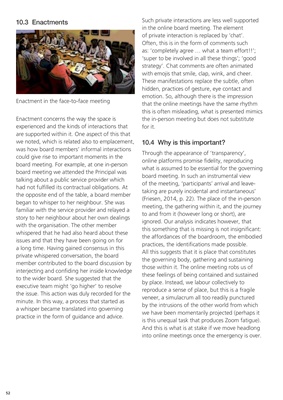
52 10.3 Enactments
Enactment concerns the way the space is
experienced and the kinds of interactions that
are supported within it. One aspect of this that
we noted, which is related also to emplacement,
was how board members' informal interactions
could give rise to important moments in the
board meeting. For example, at one in-person
board meeting we attended the Principal was
talking about a public service provider which
had not fulfilled its contractual obligations. At
the opposite end of the table, a board member
began to whisper to her neighbour. She was
familiar with the service provider and relayed a
story to her neighbour about her own dealings
with the organisation. The other member
whispered that he had also heard about these
issues and that they have been going on for
a long time. Having gained consensus in this
private whispered conversation, the board
member contributed to the board discussion by
interjecting and confiding her inside knowledge
to the wider board. She suggested that the
executive team might 'go higher' to resolve
the issue. This action was duly recorded for the
minute. In this way, a process that started as
a whisper became translated into governing
practice in the form of guidance and advice.
Such private interactions are less well supported
in the online board meeting. The element
of private interaction is replaced by 'chat'.
Often, this is in the form of comments such
as: 'completely agree … what a team effort!!';
'super to be involved in all these things'; 'good
strategy'. Chat comments are often animated
with emojis that smile, clap, wink, and cheer.
These manifestations replace the subtle, often
hidden, practices of gesture, eye contact and
emotion. So, although there is the impression
that the online meetings have the same rhythm
this is often misleading, what is presented mimics
the in-person meeting but does not substitute
for it.
10.4��Why�is�this�important?
Through the appearance of 'transparency',
online platforms promise fidelity, reproducing
what is assumed to be essential for the governing
board meeting. In such an instrumental view
of the meeting, 'participants' arrival and leavetaking are purely incidental and instantaneous'
(Friesen, 2014, p. 22). The place of the in-person
meeting, the gathering within it, and the journey
to and from it (however long or short), are
ignored. Our analysis indicates however, that
this something that is missing is not insignificant:
the affordances of the boardroom, the embodied
practices, the identifications made possible.
All this suggests that it is place that constitutes
the governing body, gathering and sustaining
those within it. The online meeting robs us of
these feelings of being contained and sustained
by place. Instead, we labour collectively to
reproduce a sense of place, but this is a fragile
veneer, a simulacrum all too readily punctured
by the intrusions of the other world from which
we have been momentarily projected (perhaps it
is this unequal task that produces Zoom fatigue).
And this is what is at stake if we move headlong
into online meetings once the emergency is over.
Enactment in the face-to-face meeting